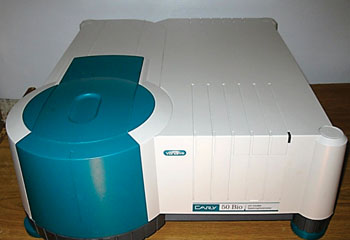Harmless Bacteria Thrive in Patients with Inflammatory Bowel Disease
By LabMedica International staff writers
Posted on 27 May 2015
The survival and proliferation of usually harmless Escherichia coli in the gut of inflammatory bowel disease patients may now be better understood, as fundamental mechanism through which the bacteria can thrive during flare-ups has been defined.Posted on 27 May 2015
Some strains of E. coli normally live in the intestines of humans, and are important for a healthy digestive tract, but for people who suffer from inflammatory bowel diseases (IBD), these innocuous strains may proliferate during a flare-up and further contribute to disease and discomfort.

Image: The CARY 50 BIO UV-Visible Spectrophotometer (Photo courtesy of Agilent Technologies).
Scientists at Pennsylvania State University (University Park, PA, USA) and their colleagues studied the interactions between enterobactin, myeloperoxidase and lipocalin 2 and how they regulate E. coli in the intestine. Enterobactin (Ent) is an iron-loving chemical secreted by E. coli that takes iron from host proteins in the body and aids the proliferation of E. coli. Myeloperoxidase (MPO) is an antibacterial protein that white blood cells produce to fight bacteria, however Ent inhibits MPO from doing its job. Lipocalin 2 (Lcn2) is another protein, also produced by white blood cells, that gathers up Ent so that bacteria fail to obtain a sufficient amount of iron for their survival.
Spectral analysis of lactoperoxidase (LPO) during the oxidation of Ent, 2,3-dihydroxybenzoic acid (DHBA) and 4-aminobenzoic hydrazide (ABAH) was recorded at 412 nm using CARY50BIO UV-Visible Spectrophotometer (Agilent Technologies; Santa Clara, CA, USA). By using various techniques the team found that Lcn2 can counter the effects of Ent on MPO. They were able to define a new defense mechanism used by E. coli residing in a human or animal host, the inhibition of MPO by Ent. These findings define a fundamental mechanism by which E. coli surpasses the host innate immune responses during inflammatory gut diseases and gains a distinct survival advantage.
Matam Vijay-Kumar, PhD, an assistant professor of nutritional sciences and medicine and lead author of the study said, “Several types of inflammatory bowel disease are characterized by expansion of the opportunistic E. coli in the gut. However, the mechanisms by which E. coli can thwart the hostile host innate immune system are poorly understood. Identifying these mechanisms will help to reduce the E. coli burden in the inflamed gut and prevent chronic extra-intestinal diseases. We have to find a way to identify the drugs which can inhibit or degrade secreted enterobactin. Alternatively, since MPO is known to be pro-inflammatory not only in IBD but also in other inflammatory diseases, it may be possible to develop enterobactin-based drugs to alleviate inflammatory pathways.” The study was published on May 12, 2015, in the journal Nature Communications.
Related Links:
Pennsylvania State University
Agilent Technologies












.jpg)
